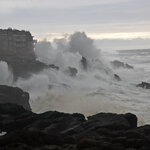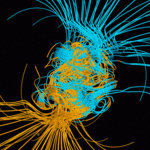Geology

The January 12th earthquake in Haiti killed an estimated 200,000 people and left 1.5 million homeless. Now, researchers are returning to the island this week to determine whether the quake could trigger another major event to the east or west of Haiti's capital Port-au-Prince. Most aftershocks occur within weeks of the initial quake and the team urgently needs to get to the site to make a detailed assessment before crucial geological information disappears.
"The big question is instead of small aftershocks, could there be a bigger earthquake coming," Team leader Eric Calais said. "There are…

Scientists from Oregon State University and the Oregon Department of Geology and Mineral Industries say a major increase in maximum ocean wave heights off the Pacific Northwest in recent decades has forced scientists to re-evaluate how high a "100-year event" might be, and raises special concerns about flooding, coastal erosion and structural damage.
The new assessment, published in the journal Coastal Engineering, concludes that the highest waves may be as much as 46 feet, up from estimates of only 33 feet that were made as recently as 1996, and a 40 percent increase. December and January…

The natural climate archives recorded in a stalagmite from a limestone cave in southern Arizona link the Southwest's winter precipitation to temperatures in the North Atlantic, according to new research in Nature Geoscience. The finding is the first to document that the abrupt changes in Ice Age climate known from Greenland also occurred in the southwestern U.S.
The stalagmite yielded an almost continuous, century-by-century climate record spanning 55,000 to 11,000 years ago. During that time ice sheets covered much of North America, and the Southwest was cooler and wetter than it is now.…

This morning I was asked to settle an argument about the Magnetic North Pole being a magnetic south pole. That discussion started me wondering about the dynamo theory, widely accepted now, that the Earth's swirling, agitating liquid outer core, interacting through convection with Earth's inmost magnetism, is what regenerates our planet's geomagnetic field.
Earth's inner core of solid iron, at approximately 4000°C is too hot to sustain magnetism through eons of geologic time, by itself.
Recently I was surprised to read that, since 1989, The Magnetic North Pole's migration towards Russia has…

The disastrous magnitude 7.0 earthquake that triggered destruction and mounting death tolls in Haiti this week occurred in a highly complex tangle of tectonic faults near the intersection of the Caribbean and North American crustal plates, according to a geologist at the Woods Hole Oceanographic Institution (WHOI).
Jian Lin, a WHOI senior scientist in geology and geophysics, said that there were three factors that made the quake particularly devastating: First, it was centered just 10 miles southwest of the capital city, Port au Prince; second, the quake was shallow—only about 10-15…
According to four studies appearing in the latest issue of the Journal of Volcanology and Geothermal Research, the plumbing that feeds the Yellowstone supervolcano shows a plume of molten rock rising at an angle from the northwest at a depth of at least 410 miles, contradicting claims that there is only shallow hot rock moving like slowly boiling soup.
The research also indicates that the banana-shaped magma chamber of molten rock a few miles beneath Yellowstone is 20 percent larger than previously believed, so a future cataclysmic eruption could be even larger than thought.
The studies…

An international team of environmental scientists says that sea-level rise along the Atlantic Coast of the United States in the 20th century was 2 millimeters faster than at any point in the last 4,000 years.
Sea-level rise prior to the 20th century is generally attributed to coastal subsidence. This occurs as land is lost to subsidence as the earth continues to rise in response to the removal of the huge weight of ice sheets during the last glacial period.
Using sediment cores from the U.S. Atlantic coast, researchers found significant spatial variations in land movement, with the mid…

A potentially dangerous level of carbon dioxide and methane gas haunts Lake Kivu, the freshwater lake system bordering Rwanda and the Republic of Congo.
Scientists can't say for sure if the volatile mixture at the bottom of the lake will remain still for another 1,000 years or someday explode without warning. In a region prone to volcanic and seismic activity, the fragility of Lake Kivu is a serious matter. Compounding the precarious situation is the presence of approximately 2 million people, many of them refugees, living along the north end of the lake.
An international group of researchers…

Satellite observations and a state-of-the art regional atmospheric model have independently confirmed that the Greenland ice sheet is loosing mass at an accelerating rate, according to a new study published in Science.
The mass loss is equally distributed between increased iceberg production, driven by acceleration of Greenland's fast-flowing outlet glaciers, and increased melt water production at the ice sheet surface. Recent warm summers further accelerated the mass loss to 273 Gt per year (1 Gt is the mass of 1 cubic kilometer of water), in the period 2006-2008, which represents 0.75 mm…
We soak up the breathtaking views after a long morning's paddle. The east and south sides of our route are bound by the imposing white peaks of the Cariboo Mountains, the northern boundary of the Interior wet belt, rising up across the Rocky Mountain Trench, and the Isaac Formation, the oldest of seven formations that make up the Cariboo Group. Some 270 million plus years ago, had one wanted to buy waterfront property in what is now British Columbia, you’d be looking somewhere between Prince George and the Alberta border. The rest of the province had yet to arrive but would be made up of…